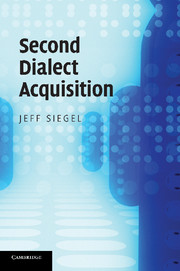Book contents
- Frontmatter
- Contents
- List of figures
- List of tables
- Acknowledgements
- List of abbreviations
- 1 Introduction
- 2 Attainment in naturalistic SDA
- 3 Acquiring a second dialect
- 4 Differential attainment: Age effects and linguistic factors
- 5 Additional individual and linguistic factors
- 6 The difficulty of SDA
- 7 SDA in classroom contexts
- 8 Educational approaches for SDA
- 9 Explaining the results and taking further steps
- Notes
- References
- Index
5 - Additional individual and linguistic factors
Published online by Cambridge University Press: 07 September 2010
- Frontmatter
- Contents
- List of figures
- List of tables
- Acknowledgements
- List of abbreviations
- 1 Introduction
- 2 Attainment in naturalistic SDA
- 3 Acquiring a second dialect
- 4 Differential attainment: Age effects and linguistic factors
- 5 Additional individual and linguistic factors
- 6 The difficulty of SDA
- 7 SDA in classroom contexts
- 8 Educational approaches for SDA
- 9 Explaining the results and taking further steps
- Notes
- References
- Index
Summary
As mentioned in the preceding chapter, in order to account for differential results in D2 attainment, studies of SDA have examined both individual factors relating to learners, and linguistic factors relating to variables. This chapter looks at additional factors in both of these categories.
Additional individual factors
In addition to age of acquisition (AoA), individual factors studied in SDA include length of residence, social identity, gender, degree of social interaction with D2 speakers, motivation and attitudes, and occupation. These factors and their relationships are described here.
Length of residence (LoR)
One of the most commonly examined factors in studies of naturalistic SDA is length of residence (LoR) – i.e. how long the acquirer has lived in the D2 region. The LoRs, or ranges of LoR among subjects, for each of the seventeen studies examined inChapter 2 are given in Table 4.1 in the preceding chapter. A quick glance at the first three studies seems to indicate that LoR is not a consistently significant factor, since the children in Tagliamonte and Molfenter's (2007) study reached native-like usage after six years but those in Trudgill's (1981) did so in less than one year, and some in Berthele's (2002) did so in two years whereas others did not. The rest of the figures for LoR are not very helpful because of the wide ranges. But we do find many examples of subjects with long LoRs yet very low percentages of use of D2 variants.
- Type
- Chapter
- Information
- Second Dialect Acquisition , pp. 101 - 133Publisher: Cambridge University PressPrint publication year: 2010



